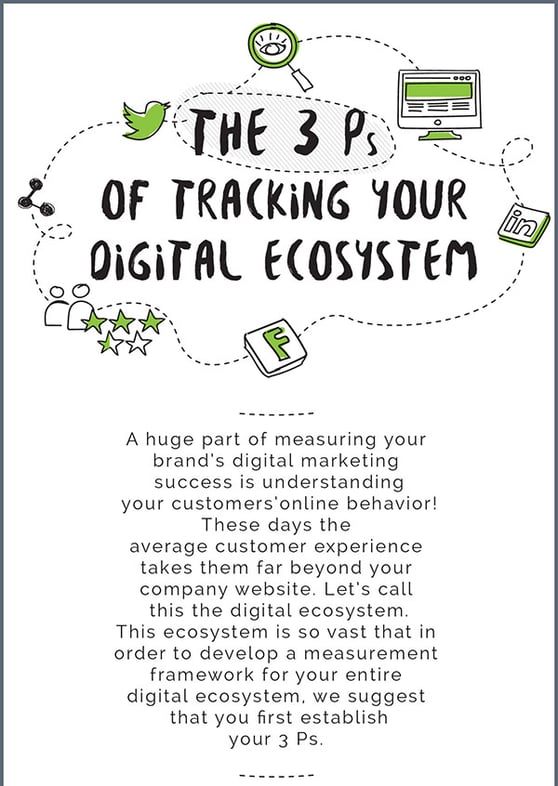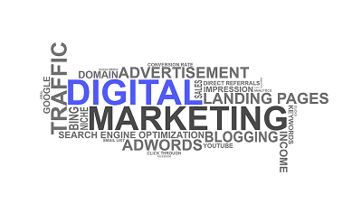The biggest part of measuring your brand’s digital marketing success is understanding your customers’ online behavior and your digital ecosystem. There's a lot of talk about the importance of numbers in this age of Big Data, and with good reason - analytics are vital to digital marketing success. But if you don't know what you're measuring or why, all the data in the world won't make an impact, regardless of how much you collect. Until you know what you want to accomplish with your digital strategy, the numbers are secondary.
We've probably said it before, but in the digital space, it really is all about your customers. The journey you've laid out - or perhaps most critically, neglected to layout - is the foundation upon which everything else should be built. Your customers and their journey are what defines your digital ecosystem.
How to Track Your Digital Ecosystem
In order to bring you up to speed on the 3 Ps of tracking your digital ecosystem as it relates to collecting meaningful data on your customers, we created another infographic for your learning pleasure. Happy analyzing!
Thinking about all the components of a digital marketing strategy can be a daunting exercise. There's a lot of stuff, and if you're not actively keeping up with the industry, you can fall behind your competitors in the blink of an eye. But we hear you, we know it's tough out there. This is why we're here to tell you that focusing on a) your customers and their experience and b) the 3 Ps will go a long way in making things a little easier for you or your team to handle. So without further ado, here are the 3 Ps of tracking your digital ecosystem:
The first P is for property. Your digital properties are the face of your brand in the online world. I like to think of a website as a brand's virtual representation of a large office building. If you were to walk into a company's office space it would have a huge impact on your perception of that company. In the same way, a website, which is often the first digital experience a potential customer has with your brand, will leave a lasting positive or negative impression on visitors.
Another component of the first P is the three different kinds of digital properties your brand should be engaged with. We talked about websites, which are 100% controlled by the brands that own them. Social media is a two-way street between brands and the followers they engage with, so these are only partially controllable. And finally, third party review sites are vital properties that are completely controlled by other parties.
The real key to the first P is understanding what you can control versus what you need to influence, and the difference between the two extremely important aspects of managing your digital ecosystem.
The second P is for path - that is, the path that leads a customer to complete the action you've laid out for them. The first two Ps go hand-in-hand since before you set down a path, you first need to know which properties your customers are engaging with.
Think of it like a drive-thru at a fast-food joint. You are presumably drawn to a fast-food restaurant by some form of marketing. Your first interaction is over an intercom, where you place your order. From there, you drive to the first window where you make your payment, and then to the second drive-thru window to collect your food.
The point is there's a distinct, repeatable path that customers are required to follow in order to use a drive-thru. This should be the case for a customer who wants to engage with your digital properties as well. You should be driving your customer to the most attractive property you own (hopefully your website) and then directing them to an obvious "buy zone" (like the payment window at a drive-thru). And finally, just as a drive-thru attendant hands you food with a big smile and a hearty thank you, the customer's experience with your brand should continue after they make a purchase. Remember, loyal brand advocates and repeat business is vital to future success.
The point at which everything we've discussed so far intersects with data and numbers is right here at the final P: purpose. The properties and the path both depend on the purpose, which in most cases is simply the reason you exist. For example, if the purpose of your website is to convert visitors into customers, then you know exactly what you need to measure: the number of leads and sales your website is receiving. If you have a campaign geared toward earning positive reviews and creating a "buzz" about your brand, then you should be measuring the ratio of positive to negative feedback that this purpose generates.
Understanding the three Ps is a great way to get a handle on your brand's digital ecosystem and begin tracking the metrics that matter the most. Within the hectic, face-paced digital environment, it can be tough to decide what to measure and why, but the three Ps make it easy. Analyze and optimize your properties, lay out a path from your customers, and match the metrics you measure to your overall purpose.
That's the end of the line for our digital ecosystem infographic, but here's the whole thing in its entirety, along with an embed code in case you'd like to share and write about it on your site.








